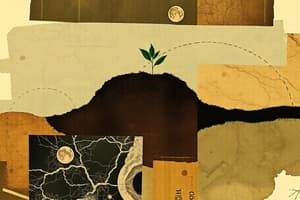Podcast
Questions and Answers
What are some key nutrients that plants require to thrive in healthy soils?
What are some key nutrients that plants require to thrive in healthy soils?
- Sodium, Chlorine, Manganese
- Nitrogen, Phosphorus, Potassium (correct)
- Calcium, Iron, Zinc
- Sulfur, Copper, Boron
How can soil erosion negatively impact agricultural outcomes?
How can soil erosion negatively impact agricultural outcomes?
- Promote environmental conservation
- Reduce soil depth (correct)
- Increase soil fertility
- Enhance crop yields
Which practice helps in mitigating soil erosion by protecting the soil surface?
Which practice helps in mitigating soil erosion by protecting the soil surface?
- Random Crop Planting
- No Crop Rotation
- Residue Mulching (correct)
- Excessive Tillage
What is a crucial step in conserving soil resources for sustainable food production?
What is a crucial step in conserving soil resources for sustainable food production?
How does high soil fertility contribute to robust crop yields and food production?
How does high soil fertility contribute to robust crop yields and food production?
Which agricultural practice can help protect soil health by reducing the need for excessive chemical inputs?
Which agricultural practice can help protect soil health by reducing the need for excessive chemical inputs?
What are the primary components of soil composition?
What are the primary components of soil composition?
How is soil primarily classified?
How is soil primarily classified?
Which component derived from dead organisms improves soil structure?
Which component derived from dead organisms improves soil structure?
What is the function of water in soil?
What is the function of water in soil?
Which category of soil contains varying proportions of organic matter, minerals, air, and water?
Which category of soil contains varying proportions of organic matter, minerals, air, and water?
What role do gases like oxygen and carbon dioxide play in soil composition?
What role do gases like oxygen and carbon dioxide play in soil composition?
Flashcards are hidden until you start studying
Study Notes
Exploring Soil: A Vital Resource Essential for Life
As you delve into the fascinating world of soils, it's essential to understand their diverse nature and importance for sustaining plant growth, combating climate change, and ensuring food security. Let's unravel the five key aspects of this dynamic medium we call earth's topsoil.
Types of Soil
Soil is primarily classified according to its formation processes, parent materials, and properties like texture, structure, and color, yielding distinct categories such as sandy loam, clay, silt loams, and peat among others. Each type contains varying proportions of organic matter, minerals, air, and water, shaping how plants grow within them.
Soil Composition
Most soils consist of four primary components: mineral particles, organic matter, water, and gases like oxygen and carbon dioxide. These constituents interplay intricately, dictating the soil's health and productivity. Minerals comprise rock fragments, clay, silt, and sand, forming the foundation for all soil types. Organic matter — derived from dead organisms and plant residues — adds nutrients, improves soil structure, and boosts water retention. Water facilitates root penetration while being held by capillary forces between soil particles, allowing for vital functions like photosynthesis and transpiration.
Soil Fertility
Plants require specific nutrients, including nitrogen, phosphorus, potassium, calcium, sulfur, magnesium, iron, manganese, copper, zinc, boron, and chlorine, to thrive. Healthy soils contain these elements, promoting robust crop yields and food production. However, maintaining high levels of soil fertility requires careful management and control over factors like land usage, tillage practices, manure application, and irrigation methods.
Soil Erosion
Another critical aspect of soil integrity deals with erosion, caused by various natural events such as wind, water, ice, gravity, and human activities. Uncontrolled erosion can significantly decrease soil depth, resulting in poor agricultural outcomes and environmental degradation. To mitigate erosion, farmers implement strategies such as crop rotation, residue mulching, contour farming, agroforestry, and terracing.
Soil Conservation
Conserving soil resources entails actively protecting existing healthy soils and improving damaged ones through sustainable agricultural techniques. By preserving soil quality, protecting against erosion, enhancing biodiversity, and increasing resiliency toward changing climatic conditions, we ensure our ability to produce enough food to feed growing populations worldwide. Some concrete measures for soil conservation include using cover crops, reducing tillage, employing integrated pest management systems, and implementing precision agriculture technologies.
In conclusion, soil encompasses a multitude of complexities yet remains one of the most fundamental facets of life on Earth. Its classification, composition, fertility, erosion, and conservation must be understood deeply if we wish to continue producing abundant healthy foods sustainably and responsibly.
Studying That Suits You
Use AI to generate personalized quizzes and flashcards to suit your learning preferences.




